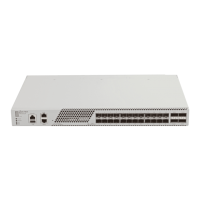MES53xx, MES33xx, MES23xx Ethernet Switch Series 9
Table 2.2. MAC address processing features
The switch creates an in-memory look-up table that maps MAC addresses and
switch port nodes.
When learning is not available, the incoming data on a port will be transmitted to
all other ports of the switch. Learning mode allows the switch to analyse the
frame, discover sender's MAC address and add it to the routing table. Then, if the
destination MAC address of an Ethernet frames is already in the routing table, that
frame will be sent only to the port specified in the table.
This feature enables one-to-many and many-to-many data distribution. Thus, the
frame addressed to a multicast group will be transmitted to each port of the
group.
Automatic Aging for
MAC Addresses
If there are no packets from a device with a specific MAC address in a specific
period, the entry for this address expires and will be removed. It keeps the switch
table up to date.
The network switch allows you to define static MAC entries that will be saved in
the routing table.
2.2.3 Layer 2 Protocol Tunneling (L2PT) Features
Table 2.3 lists Layer 2 features and special aspects (OSI Layer 2).
Table 2.3. Layer 2 feature description (OSI Layer 2)
IGMP Snooping
(Internet Group
Management Protocol)
IGMP implementation analyses the contents of IGMP packets and discovers
network devices participating in multicast groups and forwards the traffic to the
corresponding ports.
MLD Snooping
(Multicast Listener
Discovery)
MLD protocol implementation allows the device to minimize multicast IPv6 traffic.
MVR
(Multicast VLAN
Registration)
This feature can redirect multicast traffic from one VLAN to another using IGMP
messages and reduce uplink port load. Used in III-play solutions.
Broadcast storm is a multiplication of broadcast messages in each host causing
their exponential growth that can lead to the network meltdown. The switches
can restrict the transfer rate for multicast and broadcast frames received and sent
by the switch.
Port mirroring is used to duplicate the traffic on monitored ports by sending
ingress or and/or egress packets to the controlling port. Switch users can define
controlled and controlling ports and select the type of traffic (ingress or egress)
that will be sent to the controlling port.
This feature assigns the uplink port to the switch port. This uplink port will receive
all the traffic and provide isolation from other ports (in a single switch) located in
the same broadcast domain (VLAN).
This feature isolates the ports in a group (in a single switch) located in the same
broadcast domain from each other, allowing traffic exchange with other ports that
are located in the same broadcast domain but do not belong to this group.

